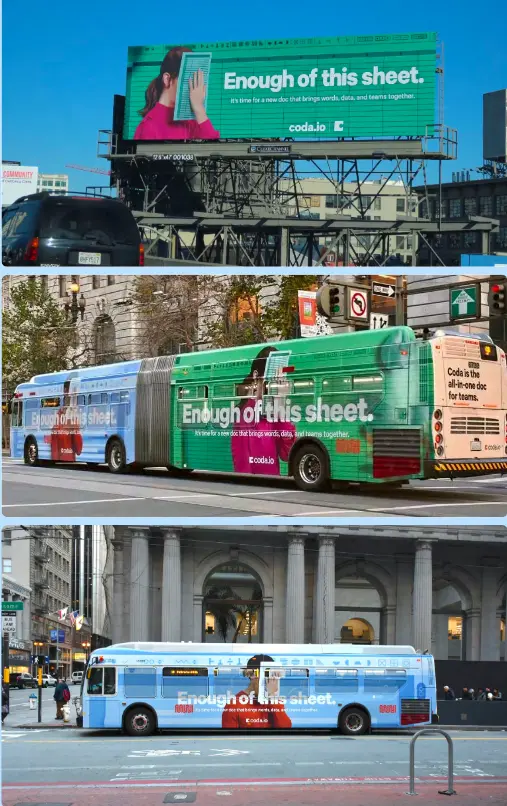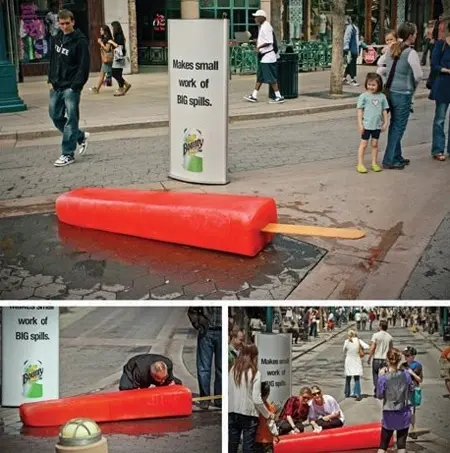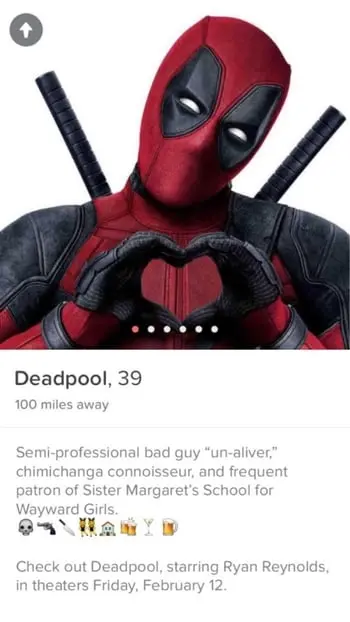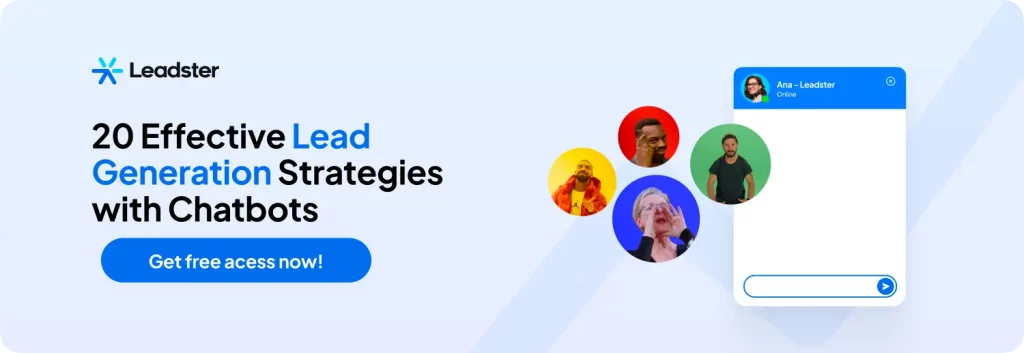What is Guerrilla Marketing and How to Get Started?
Guerrilla Marketing is a highly interesting strategy, but unfortunately, it’s not well-utilized by everyone.
But here’s the thing: I’m not saying there are few examples of Guerrilla Marketing in Brazil and around the world. They do exist and are everywhere.
However, these actions tend to be underutilized by small businesses or brands that prioritize digital marketing.
In today’s article, I want to turn the page on that. If you run a small business, you’ll learn what Guerrilla Marketing is and how to implement it on a local scale, in a way that works for you.
But if you have a good budget and support from your board for a guerrilla campaign, I’ve brought some great Brazilian examples to inspire you.
Shall we begin?
What is Guerrilla Marketing?

Guerrilla Marketing is the term for a methodology that seeks to create unexpected and creative actions, directly inserting them into the routine of the target audience.
“But wait,” you might be thinking, “isn’t that the definition of marketing and advertising as a whole?”
In a way, yes, but Guerrilla Marketing goes much further.
Think of a billboard, for example. It’s created with creativity in mind and truly impacts people’s routines. Take a look at this example:

Is it a disruptive and creative action? Definitely. But not at the level Guerrilla Marketing can reach.
This is because the term “guerrilla” is not used lightly. A brand carrying out a Guerrilla Marketing action aims to occupy spaces that are not typically associated with advertising.
For example, doing an action in the middle of a square, in a shopping mall corridor, at a traffic light, or on an office building.
The main rule of Guerrilla Marketing is to offer an experience to the target audience. And the experience needs to be impactful enough for the action to be shared with more people, making it viral.
This sharing takes various forms: online, through word-of-mouth, and even through traditional media.
So, a billboard, a bus ad, or a mall totem cannot be considered Guerrilla Marketing because everything about them is already expected by the public; there’s nothing different.
However, all of this doesn’t stay in the realm of ideas. There are specific characteristics defined by various authors and marketing researchers.
We will delve into each of these characteristics and triggers of Guerrilla Marketing. But for now, let’s move on to a more practical topic:
What Are the Types of Guerrilla Marketing?

Guerrilla Marketing can be executed in several different ways.
Many people think it’s only the traditional approach: doing some street action and inviting the media to film and share the message.
But it’s not quite that simple. Guerrilla Marketing can take different forms, impacting thousands of people at once or just one or two.
It can be done on the street, inside a space, and can last just a few hours or extend over months and even years!
For example, the virtual reality game created for the launch of the movie “The Dark Knight” in 2008 involved over 650,000 players over several months.
One of the “clues” even featured 5 planes in the sky writing a phone number. The campaign was so extensive that fans even created a Wiki with its history.
So, Guerrilla Marketing is like a state of mind 👻 It can present itself in various forms as long as its main principles are respected.
What forms are these? Let’s find out together now:
Outdoor Guerrilla Marketing
This is the classic case: Guerrilla Marketing done on the street, activating a brand, and involving people passing by.
But at the same time, this type of action is the most complicated to plan.
First, you’ll need to determine where your target audience usually gathers. And that alone is quite a job.
Next, you’ll need to understand what permissions you’ll need to conduct your action — usually, this approval comes from the city council through the Civil Guard or with the endorsement of the Fire Department/Police.
Before carrying out the action, you’ll need to handle all the logistics — promoters, structure, food, transportation, etc.
Finally, during the execution, you’ll need senior marketing staff dedicated to overseeing the entire development.

Along with this type, the next is also quite popular:
Indoor Guerrilla Marketing
This type of Guerrilla Marketing is done inside another structure — in a shopping mall, an office building, or anywhere your target audience is.
These cases are usually a bit simpler, especially in terms of research. The tricky part is getting approval if you’re proposing a more unusual location — like a subway station.
But in any case, the planning and execution of the action are quite similar to Outdoor Guerrilla Marketing.
Guerrilla Marketing at Events
This type of Guerrilla Marketing is done within the structure of another event. Such actions are very popular at marketing events, like RD Summit, for example.
But they can also occur at other types of events, such as concerts and soccer games.
In the case of events, usually, the organizers are approached by brands with their offers of actions.
At concerts, either the event organizer provides the opportunity for the action or the venue itself negotiates with agencies.
At soccer games, it’s a bit more complicated, as the practice is often banned by FIFA, but it still happens.
A classic example is the legend that celebrating a goal by making the number 1 with your hand was actually a placement by Brahma for the 1994 World Cup, which allegedly paid Romário to popularize the gesture — the brand’s slogan at the time was “The Number 1.”
Digital Guerrilla Marketing
Many people think it’s impossible to do Guerrilla Marketing digitally, but that’s not quite true.
Nowadays, Guerrilla Marketing in the digital space is gaining a lot of traction, mainly because the channel is much cheaper than creating physical campaigns.
An example: for the release of the Deadpool movie, which was close to Valentine’s Day, the agency working with Fox created a fake Tinder profile for the hero:

Anyone who matched with the chatty mercenary immediately received links to buy tickets for the nearest cinema.
But here’s a common problem with guerrilla marketing: Tinder doesn’t allow its users to do advertising. Many guerrilla actions are carried out without prior authorization, or even with an explicit ban.
This is one of the reasons that drive the intense creativity of such actions: it needs to impact quickly because the longer the action runs, the less control the marketing team has over it.

What Are the Five Characteristics of Guerrilla Marketing?

Guerrilla Marketing does have formal definitions worth knowing.
These definitions will help you understand what the main characteristics of your actions should be.
And this is important. Many brands believe that to do Guerrilla Marketing, you only need to come up with something creative and put it out on the street.
But it’s not that simple. Every Guerrilla Marketing action that aims for the best possible results needs to consider these five fundamental characteristics.
They serve two purposes: to describe an action as guerrilla or not and to ensure that actions have the maximum effectiveness.
These characteristics were initially proposed by Jay Conrad Levinson in his 1984 book “Guerrilla Marketing.”
By the way, just a quick note: this book is essential for anyone planning guerrilla actions and also for anyone who just loves marketing and advertising in general.
Let’s dive into these characteristics now:
Unexpected
We’ve already touched on how Guerrilla Marketing needs to be unexpected by definition.
If it’s expected, part of the experience is lost. Or even the entire experience.
For example: if you do a tasting event inside a supermarket, that’s not guerrilla marketing; it’s just trade marketing.
The unexpected element is a large part of the experience. Without it, you’re just doing advertising.
And there’s nothing wrong with advertising. The point is that Guerrilla Marketing has much bigger concerns than just showcasing the brand.
It creates an experience. And for that, it needs a second element.
Interactive
For Guerrilla Marketing to be effective, it needs to be interactive. Above all, you need to allow and encourage the target audience to engage with your brand.
Interactivity doesn’t come by chance. The more senses you stimulate in a marketing action, the greater the chances of remaining in the memory of the impacted individuals.
Consider a billboard, for example. Do you remember anything that was written on the last one you saw? Probably not, and one reason is that only one sense was engaged — sight.
Touch, taste, smell, sight, and hearing — these are the five human senses, and all of them present significant opportunities for Guerrilla Marketing.
But be cautious! You don’t need to activate all senses at once or separately. You can, for instance, activate two or three. The important thing is to have interactivity.
And interaction doesn’t have to be only around these senses. It can be in more mundane forms, like seeing an item and taking it home, or receiving a call from someone.
A recent example is Spotify Wrapped 2023, which rewards top listeners of artists with a “call” at the end of the user’s musical recap.
Creative
Guerrilla Marketing that isn’t creative doesn’t feel like Guerrilla Marketing.
For instance: Petz has been running an adoption space in all its stores for years.
That’s nice, interesting, and very cool of the company. But at the same time, it’s not creative — no one stops and thinks, “Wow, Petz is doing this?”
Of course, Petz would do such an action; it’s 100% in line with their operations. So much so that it’s almost obvious.
Now, if Petz sponsored a wedding for two adopted dogs in a daycare, opened it to the public, and held a real canine reception, the story would be completely different.
If Guerrilla Marketing doesn’t look like Guerrilla Marketing, it’s just marketing. And traditional marketing — whether physical or digital — doesn’t have the advantages that guerrilla actions bring: mainly the great potential for sharing and earned media.
Simplicity
Guerrilla Marketing actions need to have a concept that is simple to understand.
But this doesn’t mean that the actions themselves need to be simple in execution.
Take the example we mentioned earlier with Batman. The action was extremely complex, both in its execution by the agency and in the public’s participation.
Yet it was delivered as an augmented reality game — an ARG. That’s its concept: you’re in a game where the goal is to discover clues to eventually be “hired” by the Joker’s gang.
Simple.
Cost-Effective
Returning to the Batman example: the action was very expensive and even involved acrobatic planes in the sky. How can such an action still have a good return?
Well, it did: it was the highest-grossing film of 2008, and after 15 years, it’s still the 47th highest-grossing film of all time.
Cost-effectiveness is related to ROI — Return on Investment.
Any Guerrilla Marketing action can be very cheap or very expensive. The example of Deadpool’s Tinder profile, for instance, had a minimal cost and massive exposure once the media started covering the story.
It’s worth being expensive or cheap, as long as the ROI is positive.
The Three Main Triggers of Guerrilla Marketing

A trigger in Guerrilla Marketing is what we understand as the starting point of the action, the concept of its existence.
For example: the Batman action is an ARG; its concept is an augmented reality game.
Guerrilla Marketing can have various types of activations, but here are the three main triggers that will determine the category of the action you’re undertaking.
Follow along to learn more:
Environment
This is when the action doesn’t interact directly with the public but encourages the public to interact with it.
This is the most common type you’ll find among Guerrilla Marketing examples.
A great example, which won several Gold Lions at Cannes in 2022, was the action by Adidas in Dubai for the launch of their women’s swimwear inspired by hijabs.
Adidas created a swimmable billboard in the middle of the beach. Those interested could try on the garments in a reserved space and actually enter the billboard, which was filled with water.
See the action in the video below:
Ambush
Ambush marketing is when a brand positions itself in a location where another competing brand is already running an action.
For example: a brand makes an insertion during a World Cup game sponsored by Budweiser.
Or when a brand runs an action at Rock in Rio, which is sponsored by Heineken.
These cases are interesting because they come with a ready-made storytelling: two brands are “competing” for customers’ attention.
Usually, the costs of ambush actions need to account for legal fees, which can be quite high.
Astroturfing
Astroturfing is a controversial guerrilla technique. Some professionals prefer not to use it due to ethical concerns.
Basically, Astroturfing is when you seek to artificially inflate the opinion about a brand or product.
For example: an artist is releasing a new album. To complement their TV and radio appearances, an agency creates multiple fake profiles on social media to speak positively about the release.
And the tactic can go even further, with profiles engaging in discussions about the brand and product with other users.
The ultimate goal of Astroturfing is to activate FOMO — Fear of Missing Out — in the target audience. “Everyone is talking about the new album by artist X; I can’t be left out.”
How Do SMEs Do Guerrilla Marketing?

As you may have noticed throughout the article, Guerrilla Marketing often ends up being restricted to large brands due to the difficulty in executing it.
It typically requires large marketing teams and a good budget, which is not so common for small and medium-sized enterprises (SMEs).
So, what about SMEs? Is Guerrilla Marketing completely out of reach for them?
Not necessarily. It’s still possible to do Guerrilla Marketing even if you’re an SME with a limited budget and a small marketing team.
The key is to reduce operational costs wherever possible.
Let’s discuss how this happens now. Follow me:
The Big Idea
Everything in Guerrilla Marketing starts with a big idea.
But for SMEs, this idea needs to be well-developed to avoid being overblown.
You need to understand that your Guerrilla Marketing action will impact local people and will involve — if all goes well — only local media.
You don’t need to worry about the costs of overly extravagant actions. Simple resources can make a big difference.
Consider also online actions, particularly involving Content Marketing and Social Ads.
These methods are simpler and less costly, and have great potential to engage people and foster interaction with the brand.
The Feasibility of the Idea
Unfeasible ideas are not ideas. They only hinder you from finding the ideal idea for your segment and business dimensions.
There’s no point in trying to take a bigger step than you can afford, both in budget and execution. Remember that Guerrilla Marketing is, above all, experimental.
The methodology is not data-driven like most digital marketing actions.
On the contrary. In most cases, you have no guarantee that your action will succeed beyond your preliminary research.
So always scale down your actions to be smaller because if you don’t achieve the results you were aiming for, at least you won’t have spent too much.
Physical or Digital?
Both strategies have their positives and negatives for SMEs.
On the positive side, physical actions have a lot of potential for spontaneous publicity from impacted people and local media.
Digital actions have the potential to reach many people for less money and, of course, less work.
But each comes with its drawbacks. Physical actions require direct and indirect expenses — you’ll spend a lot of time planning the campaign and lose a few days during its execution.
And digital actions tend to have fewer chances of standing out and appearing in the media.
It’s all a balance that you need to understand well before starting your actions, okay?
5 Examples of Guerrilla Marketing in Practice

Well, we’ve already talked quite a bit throughout the article about all the theory behind Guerrilla Marketing.
What’s left is to understand a bit better how this work operates by looking at some examples and trying to understand the actions executed by the brands.
This is simple to do, and we can start right now. Come with me?
Barbieheimer
In 2023, two studios came together, albeit in a very organic way, to capitalize on the release of their two major films: Barbie and Oppenheimer.
One film is about the inventor of the atomic bomb. And the other is about Mattel’s most successful doll. Do they combine?
The fact is that this union was far from planned. The cinema audience itself went viral with a challenge on social media: to watch Barbie and Oppenheimer, two completely opposite films, on the same day.
In fact, AMC Theaters, the American ticket club, tweeted that 20,000 of its members bought tickets for both films on the same day.
There’s a small story behind this phenomenon. The Barbie film was released on the same day as Oppenheimer due to a studio rivalry.
Christopher Nolan, the director of Oppenheimer, left Warner in 2020 after 20 years of exclusivity with the studio. Oppenheimer was supposed to be distributed by Warner, but Nolan chose to take the film to Universal.
To compete with the director, Warner changed the release date of Barbie, creating a simultaneous launch.
In this case, it’s quite difficult to pinpoint exactly where the studios engaged in Guerrilla Marketing. Some say it was Astroturfing — the memes were created by the studios — but it’s more likely that the films went viral through a more interesting technique.
In the film and television world, this phenomenon has a name: counter-programming. The technique involves releasing a completely different material from what your competitor is launching on the same day.
In the video game world, we saw something similar in 2020 when Doom Eternal was released on the same day as Animal Crossing. The phenomenon was similar, and the spontaneous viral marketing helped both sell more.
Well folks, is it clear what Guerrilla Marketing is all about? I really hope so!
Thanks for reading and, if you have any doubts, feel free to drop a comment. We answer every one of them.




![20 Marketing Strategies for Startups [Growth-Focused]](https://getleadster.com/blog/wp-content/uploads/2024/04/20-estrategias-de-marketing-para-startups-com-foco-em-growth.webp)



